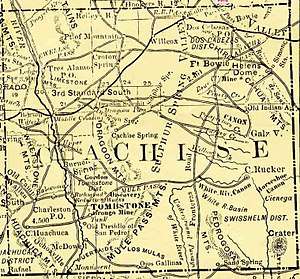John Horton Slaughter
John Horton Slaughter (October 2, 1841 – February 16, 1922), also known as Texas John Slaughter, was an American lawman, cowboy, poker player and rancher in the Southwestern United States during the late 19th and early 20th centuries. After serving in the Confederate States Army during the American Civil War, Slaughter earned a reputation fighting hostile Indians and Mexican and American outlaws in the Arizona and New Mexico territories. In the latter half of his life, he lived at the San Bernardino Ranch, which is today a well-preserved National Historic Landmark in Cochise County in far southeastern Arizona. In 1964, he was inducted into the Hall of Great Westerners of the National Cowboy & Western Heritage Museum.[2]
John Horton Slaughter | |
|---|---|
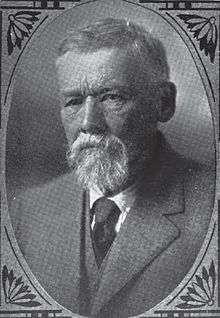 | |
| Birth name | John Horton Slaughter |
| Nickname(s) | Texas John Slaughter |
| Born | October 02, 1841 Sabine Parish, Louisiana, United States |
| Died | February 16, 1922 (aged 80) Douglas, Arizona |
| Battles/wars | American Civil War American Indian Wars |
| Spouse(s) | Eliza Adeline Harris Slaughter (married 1871–1877, her death) Cora Viola Howell Slaughter (married 1879–1921, his death) |
| Relations | From first marriage: Addie Slaughter |
| Other work | Texas Ranger, rancher, sheriff, United States Marshal |
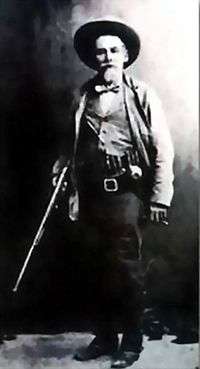
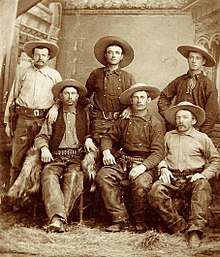
Biography
Early life
Slaughter was born in 1841 on a Southern plantation in Sabine Parish near Many in western Louisiana.[3][4][5][6] His parents were Benjamin Slaughter and the former Minerva Mabry.[3] He was educated in schools in Texas in Sabine County and Caldwell County.[3] From Mexican vaqueros, he learned how to herd cattle and how to speak Spanish.[3]
In the early 1860s, Slaughter defended European settlers against hostile Comanche as a Texas Ranger.[3] Shortly after, during the Civil War, he served in the Confederate States Army.[3] He fought Union forces in Burnet County, west of the capital city of Austin, Texas.[3][5]
Career
In 1874, he, along with his brother, became a cattle driver in Atascosa County, south of San Antonio.[3] The two formed a cattle-transporting company, the San Antonio Ranch Company, which drove cattle to Kansas via the Chisholm Trail.[3][6] One (if not the only) of his cattle drive bosses was his first cousin Lewis Warren Neatherlin. Neatherlin's brother, James Franklin Neatherlin, also the Slaughter brothers' first cousin, assisted on the drive.[7]
In the late 1870s, Slaughter left Texas for New Mexico, where he traded cattle and planned to start a ranch.[3] However, he eventually decided to establish the ranch in the Arizona Territory.[3] Initially settling in Charleston, Arizona, he later purchased the San Bernardino Ranch, on the U.S.–Mexico border near Douglas, in 1884.[3][5]
In 1886, Slaughter was elected sheriff of Cochise County, Arizona, five years after the infamous Gunfight at the O.K. Corral.[3][4][8][9] He was later re-elected to a second term.[3] As sheriff, he helped track Geronimo, the Apache chief who was caught on the San Bernardino Ranch.[3][5][8] Slaughter fought for law and order with his six-shooter, a repeating shotgun, and a Henry rifle.[9] He arrested desperados like the Jack Taylor Gang and brought them to justice.[5][9]
He also became a prominent poker player, often playing all night long.[6][9] He was reportedly good at bluffing.[9] He often played with the cattle baron John Chisum.[9] Once, in San Antonio, Texas, he was cheated by cattle rustler Bryan Gallagher.[6][9] Slaughter claimed the pot but Bryan fled. Slaughter tracked down Gallagher all the way to New Mexico at Chisum’s ranch and shot him down.
Personal life
Slaughter married Eliza Adeline Harris on August 4, 1871.[3][5] Of their four children, only two, Addie and Willie, survived until adulthood.[3] Eliza died in 1877 of smallpox in Tucson.[3][4]
On April 16, 1879, Slaughter, at the age of thirty-seven, married eighteen-year-old Cora Viola Howell at Tularosa, New Mexico Territory.[3][4][5] The Slaughters had no children of their own, but they adopted several children, including Apache May, whom Slaughter encountered in 1896 while chasing the Apache Kid in Mexico.[10]
Years later, when he became ill, the Slaughters moved to an apartment on Twelfth Street in Douglas, Arizona.[5][8]
In popular culture
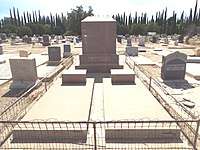
The ABC television miniseries Texas John Slaughter, with Tom Tryon in the title role, was inspired by Slaughter's life story. The series began as a Wonderful World of Disney series in 1958.[3][11]
William W. Johnstone's Texas John Slaughter series features Slaughter as a main character.[12] John Slaughter is also written about as the main character in the book Gun Justice: The unforgettable story of Texas John Slaughter, one of the greatest gunfighters of the old west by Jason Manning. Published in 1999, it chronicles his life from a ranch hand in Texas to the Arizona frontier. His life is told by himself, often when explaining his life to friends.
Robert Taylor hosted and played John Slaughter in the 1968 episode, "A Short Cut through Tombstone", on the syndicated television anthology series, Death Valley Days. Buck Taylor (no relation) played his deputy, Billy Stiles. Ned Romero was cast as the Geronimo Kid.[13]
References
- True West Magazine gallery photograph # 39
- "Hall of Great Westerners". National Cowboy & Western Heritage Museum. Retrieved November 22, 2019.
- Amanda Oren, "SLAUGHTER, JOHN HORTON," Handbook of Texas Online (http://www.tshaonline.org/handbook/online/articles/fsl10), accessed August 7, 2014. Uploaded on June 15, 2010. Published by the Texas State Historical Association.
- "John Slaughter". Archived from the original on February 6, 2015. Retrieved August 7, 2014.
- "John Slaughter Dies in Douglas". Tombstone Epitaph. February 19, 1922. p. 7.
- Clifford R. Caldwell, John Simpson Chisum: Cattle King of the Pecos Revisited, Santa Fe, New Mexico: Sunstone Press, 2010, pp. 77-78
- Kelley, J. (1988, Spring) Up the Trail in '76: The Journal of Lewis Warren Neatherlin, Chronicles of Oklahoma, 66(1), pp. 22-51. Published by the Oklahoma Historical Society
- "J. H. Slaughter Dies at Douglas". The Copper Era and Morenci Leader. Clifton, Arizona. February 17, 1922. p. 1.
- Alton Pryor, The Lawmen, Roseville, California: Stagecoach Publishing, 2006, pp. 95-97
- Wilson, Britt W. "Soldiers vs. Apaches: One Last Time at Guadalupe Canyon". HistoryNet. World History Group. Retrieved June 24, 2017.
- Billy Hathorn, "Roy Bean, Temple Houston, Bill Longley, Ranald Mackenzie, Buffalo Bill, Jr., and the Texas Rangers: Depictions of West Texans in Series Television, 1955 to 1967", West Texas Historical Review, Vol. 89 (2013), pp. 116-117
- WilliamWJohnstone.net
- "A Short Cut Through Tombstone". Internet Movie Database. Retrieved September 19, 2018.
General
- Baird, Clayton. "I Knew John Slaughter." Real West, September 1972.
- DeMattos, Jack. "Gunfighters of the Real West: John Slaughter." Real West, March 1982.
- Erwin, Allen A. The Southwest of John Horton Slaughter 1841-1922, Pioneer Cattleman and Trail-driver of Texas, the Pecos, and Arizona and Sheriff of Tombstone. Glendale, CA: The Arthur H. Clarke Company, 1965.
- Farfan, G.B. "Patchy Slaughter." Frontier Times, September 1963.
| Police appointments | ||
|---|---|---|
| Preceded by Robert S. Hatch |
Sheriff of Cochise County, Arizona 1887–1890 |
Succeeded by Carlton B. Kelton |
